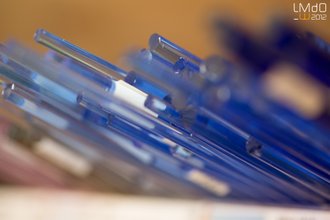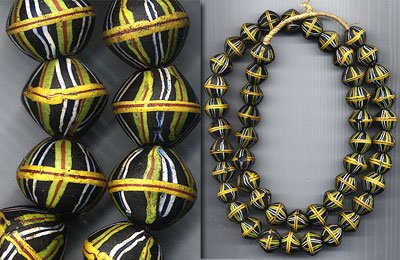AnuschB - Glass Artist
Flamework also called lampwork can be traced back to 2100 BC. It became prominent in Murano in the 14th century. A new contemporary movement around beadmaking was started some 25 years ago in the US. Today you will find Bead associations and Gatherings in France, UK, the Netherlands, Germany ...
The glass rod is heated in a flame at approx 1200 °C and wound around a mandrel coated with a separator. Once the bead is finished, it is annealed in an oven at approx. 480°C ensuring the bead’s strength. It is then allowed to cool down slowly, and removed from the mandrel. Finally, the hole is cleaned to remove the excess separator.
Making the finished piece of jewelry can now start.
Most beadmakers in Europe use sodocalcic or soft glass: Effetre or Vetrofond from Murano-IT, Lauscha or Kugler from Germany, Ornella/Jablonex from Czechia, Satake from Japan... Soft glass does melt at a lower temperature than borosilicate or hard glass, but it is also more prone to breakage when working in the flame.
The torch is fuelled with propane gas and oxygen to allow for a warmer flame
The glass comes in small rods of 7 to 15 mm with a choice of over a 100 standard transparent or opaque colours. On top of that come hand pulled and special colours, the possibility to work with glass powders, silver & gold leaf, copper..
Possibilities are endless ...
Some history on glass beads
Beads are probably the oldest ornament worn by humanity and are present in all cultures all around the world. Originaly shells, stones, teeth, bones were pierced with a hole, sometimes further engraved or polished.
Beads adorn, protect, symbolise status, serve as currency or translate beliefs. They are part of our lives and our history. Beads have all forms and colours, are made of all kind of materials as different as precious metals, wood, seeds, plastic, resin, precious and semi-precious stones ... or glass
The history of handmade glass beads dates back to 2100 BC in ancient Egypt, where glass was molten and wound around a sand core. Another important period in ancient glassmaking is the roman period from 100 B.C. to A.D. 4OO. Beads were produced in complex techniques and large quantities to be exchanged in Europe, Asia and Africa.
But the most important chapter in the story of beads from the Renaissance to the 20th century belongs to the European glass bead industry. Beads were manufactured in Venice, Holland, Bohemia and Moravia and were traded for American furs or African ivory, gold and slaves.
One of the most renowned glass making centres still today is the island of Murano close to Venice where all glass factories where relocated in 1292, to protect Venice from the risk of fires and to keep the glassmaking procedures secret. Murano beads typically are made by wound or drawn techniques.
Historic information was mainly taken from “The history of beads” by Lois Sherr Dubin: the most comprehensive book on beads I know
Trade beads, found in Africa and commonly called King Beads.




